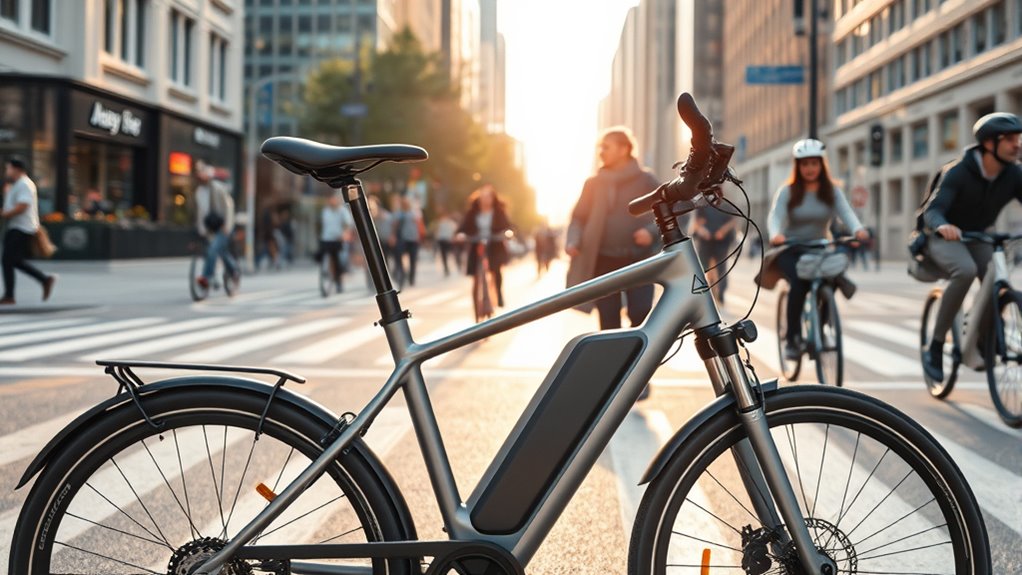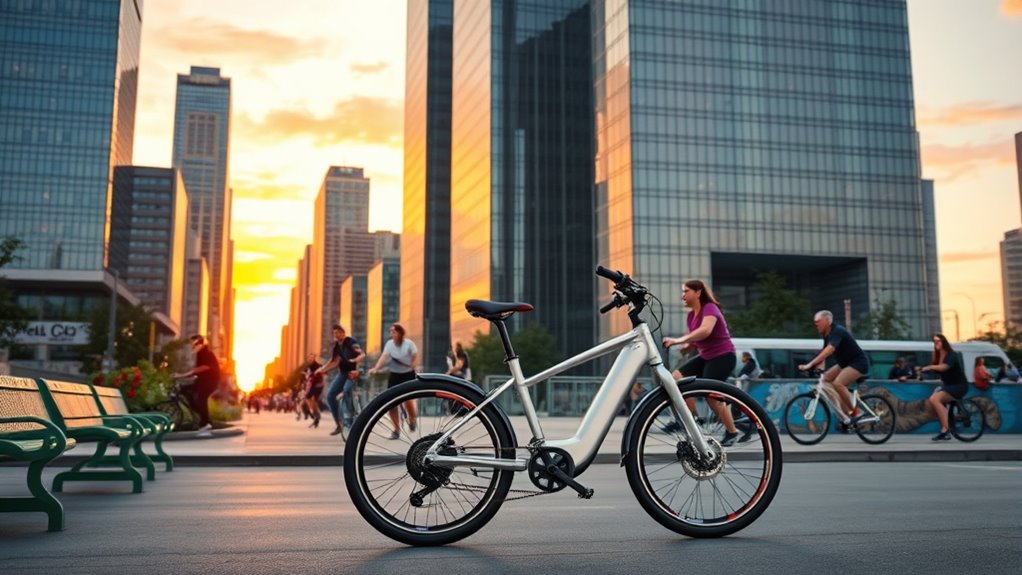E-bikes are transforming urban mobility by offering a sustainable, flexible alternative to cars. They feature advanced batteries and motors that improve range, performance, and handling, making city commutes easier and eco-friendlier. With innovative designs and smart connectivity, they help reduce traffic congestion and emissions. As cities adapt infrastructure and regulations, e-bikes become more accessible and safer. To explore how these innovations can benefit you, keep exploring the latest trends shaping urban transportation.
Key Takeaways
- E-bikes offer eco-friendly, zero-emission transportation that reduces urban air pollution and supports sustainable city development.
- Advanced battery and motor technologies enhance range, performance, and safety, making e-bikes a practical urban mobility solution.
- Integration with public transit and dedicated bike lanes improves traffic flow, reduces congestion, and promotes multi-modal commuting.
- Affordable, accessible, and easy to maintain, e-bikes provide a cost-effective alternative to cars for short-distance travel.
- Innovations in smart connectivity and safety features encourage wider adoption and transform urban transportation landscapes.
The Evolution of E-Bike Technology

The evolution of e-bike technology has transformed how people navigate urban environments, making commuting faster and more accessible. Battery advancements have played a vital role, increasing range and reducing charging times so you can travel longer distances without worry. Meanwhile, motor innovations have improved the overall efficiency and power of e-bikes, allowing for smoother rides and better performance on hilly terrain. Modern e-bikes now feature lightweight, compact batteries that fit seamlessly into the frame, enhancing balance and handling. Advanced motors provide more torque and responsiveness, giving you a natural riding experience. These technological improvements have made e-bikes more practical, reliable, and appealing for daily commuting, revolutionizing urban mobility by offering a smarter, more efficient alternative to traditional transportation. Additionally, ongoing advancements in battery technology are crucial for making e-bikes more sustainable and reducing their environmental footprint. Furthermore, innovations in motor efficiency continue to optimize power delivery and extend battery life, supporting the shift towards greener urban transit options. Moreover, the integration of sound design in e-bike features, such as audible alerts and motor noise management, enhances rider awareness and safety in busy city environments. As e-bike technology continues to evolve, components like gearing systems are being refined to improve shifting smoothness and overall ride quality.
Environmental Benefits of E-Bikes

Advancements in e-bike technology haven’t only improved performance but also contributed considerably to reducing environmental impacts. By utilizing eco-friendly materials in manufacturing, e-bikes lower the carbon footprint associated with traditional transportation. They also promote the use of renewable energy, especially when charged with solar or wind power, further decreasing reliance on fossil fuels. Incorporating sustainable practices in manufacturing processes enhances their overall environmental benefits. E-bikes produce zero emissions during operation, helping improve air quality in urban areas. Their lightweight frames and efficient batteries minimize resource consumption throughout their lifecycle. The lifespan of eco-friendly materials ensures longer-lasting bikes, reducing waste. Furthermore, the development of battery recycling programs helps mitigate potential environmental hazards associated with battery disposal. Additionally, choosing durable and refined design options aligns with a sustainable approach, extending the usability and reducing the frequency of replacements. Implementing advanced manufacturing techniques can further optimize resource use and reduce waste during production.
E-Bikes and Urban Traffic Solutions

E-bikes can play a key role in easing urban traffic by reducing congestion and making commuting more flexible. They offer a quick alternative that helps you avoid traffic jams and adapt to changing schedules. Additionally, incorporating durable survival gear such as weather-resistant shelters and reliable lighting can help cyclists prepare for unexpected weather changes and emergencies during their commutes. For example, integrating sound healing science principles can promote mental well-being during long or stressful rides. Furthermore, selecting affordable airless paint sprayers for home improvement projects can make maintenance of cycling spaces more accessible and efficient. Moreover, understanding Gold IRA rollovers can be beneficial for those looking to diversify their retirement investments, potentially providing a hedge against economic uncertainties. Using the right paint sprayer accessories can also significantly improve the quality and speed of maintenance work on cycling infrastructure. Plus, they contribute to lowering pollution levels in your city, making it more livable for everyone.
Reducing Congestion Levels
Since urban traffic congestion continues to grow, integrating e-bikes into city transportation strategies offers a practical way to ease gridlock. By promoting shared bike programs, you diminish the number of cars on crowded streets, easing congestion.
E-bikes are compact and can navigate traffic more efficiently, helping to shorten commute times. Implementing effective parking solutions for shared bikes ensures they don’t clutter sidewalks, encouraging more users to choose them over cars.
When you prioritize dedicated bike lanes and designated parking spots, you create a seamless experience that motivates commuters to switch to e-bikes. This shift not only reduces vehicle volume but also improves overall traffic flow, making cities more livable and less congested.
E-bikes are a smart, sustainable step toward alleviating urban traffic woes.
Enhancing Commuter Flexibility
By offering a versatile transportation option, e-bikes markedly enhance commuter flexibility in urban environments. With e-bikes, you can:
- Adjust your route on the fly, avoiding traffic and construction.
- Choose alternative paths that suit your schedule or scenery preferences.
- Switch between biking and walking, depending on distance and terrain.
- Combine e-bikes with public transit for seamless multi-modal commutes.
This route customization allows you to tailor your journey, saving time and reducing stress. Additionally, professional-grade e-bikes are designed to ensure safety and reliability, encouraging more users to adopt this eco-friendly mode of transportation. E-bikes give you the power to adapt to daily changes, making your commute more efficient and enjoyable.
Lowering Urban Pollution
As you explore the benefits of flexible urban commuting with e-bikes, it’s important to recognize their impact on reducing pollution. E-bikes, along with electric scooters, help cut down vehicle emissions by providing eco-friendly alternatives to cars. When integrated into bike sharing programs, they encourage more people to choose clean transportation options, reducing traffic congestion and air pollution. These shared mobility solutions make it easier to switch from polluting vehicles to electric options for short trips. Proper maintenance practices ensure the longevity and efficiency of e-bikes, maximizing their positive environmental impact. Regular battery care also plays a crucial role in maintaining optimal performance and safety. Additionally, understanding ethical hacking can help protect these smart transportation systems from cyber threats, ensuring safety and reliability for users. Implementing privacy considerations in these systems further safeguards user data and promotes trust in their widespread adoption. Moreover, advances in energy storage technology can enhance the efficiency and range of e-bikes, making them even more practical for everyday use.
Cost-Effectiveness and Accessibility

E-bikes offer a cost-effective alternative to traditional transportation methods, making urban mobility more affordable for many people. With lower maintenance costs and no need for fuel, you can enjoy significant cost savings over time. Additionally, the increasing availability of financing options and government incentives further contribute to making e-bikes an accessible choice for a wider audience. Plus, affordability options like leasing programs and government incentives help reduce upfront expenses. Consider these benefits:
- Reduced fuel and maintenance costs
- Lower purchase prices compared to cars
- Availability of financing and subsidy programs
- Minimal operating expenses for daily use
- The growing adoption of market innovations enhances the affordability and appeal of e-bikes. Efficient financial processes, such as ACH transactions, are making it easier for consumers to access these financing options and subsidies, further supporting increased adoption of e-bikes.
Design Innovations and Features

You’ll notice how lightweight frame materials make e-bikes easier to handle and carry, improving city commuting.
Advanced battery technology now offers longer range and quicker charging, so you stay on the move without delays.
Smart connectivity features let you track your ride, lock your bike remotely, and customize settings for a seamless riding experience.
Lightweight Frame Materials
Have you ever wondered how e-bikes achieve their balance between durability and portability? It all comes down to lightweight frame materials. Here’s what makes them stand out:
- Carbon fiber: Known for its strength-to-weight ratio, it offers durability without adding weight.
- Aluminum alloy: Popular for affordability and corrosion resistance, making frames lighter and sturdy.
- Titanium: Combines lightness with high strength, ideal for premium e-bikes.
- Advanced composites: Incorporate innovative materials for even lighter frames with enhanced durability.
Choosing the right material impacts your ride’s agility and ease of handling. Carbon fiber and aluminum alloy are especially common, providing a perfect mix of strength and weight savings.
This focus on materials helps e-bikes revolutionize urban mobility by making commuting effortless and efficient.
Advanced Battery Technology
Advancements in battery technology are transforming how e-bikes deliver power and extend range. You’ll notice longer battery longevity, meaning your e-bike stays powerful over more charge cycles, reducing replacement costs.
Innovative designs now utilize high-density lithium-ion cells, allowing for more compact batteries that fit seamlessly into frames.
Faster charging infrastructure also plays a vital role, enabling you to recharge your e-bike quickly at various stations around the city.
These improvements mean less downtime and more riding time, making daily commutes smoother.
Manufacturers are continually refining energy management systems to optimize power output and efficiency.
As a result, you benefit from increased reliability and confidence, knowing your e-bike’s battery is built for durability and easy access to charging points, supporting your urban mobility needs.
Smart Connectivity Features
Smart connectivity features are revolutionizing the way you interact with your e-bike, seamlessly integrating it into your urban lifestyle. Through telematics integration, your e-bike offers real-time data on battery life, location, and performance. This connectivity enhances safety and convenience by alerting you to maintenance needs or theft risks.
Here are four key innovations:
- GPS Tracking – Monitor your bike’s location and recover it if stolen.
- Performance Monitoring – Track ride stats like speed, distance, and battery health.
- Remote Control – Adjust settings or lock your e-bike via smartphone apps.
- Navigation Assistance – Get smart route planning tailored for urban environments.
These smart connectivity features make your e-bike smarter, safer, and more integrated into your daily city commute.
Challenges and Limitations

Despite their rising popularity, e-bikes face several challenges that hinder widespread adoption in urban settings. Regulatory hurdles vary by city and country, making it difficult to establish consistent rules for e-bike use. Some areas restrict where you can ride or require special licenses, creating confusion and discouraging potential riders.
Safety concerns also pose significant barriers; accidents involving e-bikes tend to be more severe due to their speed and weight. Many riders worry about vulnerability on busy streets or the lack of dedicated bike lanes, increasing the risk of collisions.
Additionally, limitations like battery range, high costs, and maintenance issues can deter users. These challenges highlight the need for clearer regulations and improved safety infrastructure to free the full potential of e-bikes in urban mobility.
The Future of E-Bike Adoption

As technology continues to improve and cities recognize the benefits of sustainable transportation, e-bike adoption is poised to grow markedly in the coming years. The rising popularity of e-bikes will influence various aspects of urban life and policy.
You can expect:
- Increased government incentives and subsidies to encourage adoption
- Stricter regulations on e-bike safety standards and usage areas
- Infrastructure investments such as dedicated bike lanes and charging stations
- Greater integration with public transportation systems for seamless commuting
These policy implications aim to support the expanding e-bike market while ensuring safety and accessibility.
As cities adapt, your opportunities to benefit from e-bikes will expand, making urban mobility more sustainable, efficient, and enjoyable.
How to Choose the Right E-Bike for You

Choosing the right e-bike depends on your specific needs and riding habits. First, consider bike size; a properly fitted bike guarantees better rider comfort and control. Measure your inseam and compare it to the bike’s frame size, especially if you’re between sizes.
Think about how you’ll use it—commuting, leisure, or off-road adventures—and select features accordingly. Rider comfort is essential; look for an adjustable seat, ergonomic handlebars, and a frame that matches your height.
Test ride different models to feel how they handle and assure the controls are intuitive. Remember, an e-bike that fits well and feels comfortable will make your rides more enjoyable and encourage regular use.
Picking the right bike now sets the foundation for a smooth, satisfying urban mobility experience.
Frequently Asked Questions
What Are the Legal Regulations Surrounding E-Bike Use Worldwide?
When you ride an e-bike, you need to know the legal regulations worldwide. You might require e-bike licensing depending on your location, especially for faster models.
Battery regulations are also vital, as many countries set limits on battery capacity for safety reasons. Always check local laws before riding to stay compliant, avoid fines, and guarantee your e-bike use is legal and safe.
How Do E-Bikes Impact Public Transportation Systems?
You’ll find e-bikes substantially impact public transportation systems by reducing traffic congestion and expanding bike sharing options.
As more people use e-bikes, they rely less on buses and trains, easing overcrowding. This shift promotes eco-friendly travel and quickens commute times.
E-bikes complement existing transit, making cities more accessible and efficient, and encouraging a shift toward sustainable urban mobility for everyone.
What Maintenance Is Required for Long-Term E-Bike Use?
Think of your e-bike as a garden that needs regular tending. To keep it running smoothly, you’ll want to focus on battery maintenance—charging it properly and avoiding extreme temperatures.
Tire upkeep is equally important: check air pressure regularly and look for worn tread. These simple steps will keep your e-bike in top shape for the long haul, ensuring smooth rides and reliable performance every time.
Are There Safety Concerns Specific to E-Bike Riders?
You should be aware of safety concerns specific to e-bike riders, like needing proper protective gear such as helmets and pads.
E-bikes can be faster and heavier, making you more vulnerable to road hazards like potholes, wet surfaces, or sudden stops.
Always stay alert, maintain safe speeds, and wear protective gear to minimize risks and stay protected from potential accidents.
How Do E-Bike Batteries Affect Overall Environmental Sustainability?
You might wonder how e-bike batteries impact environmental sustainability. They improve energy efficiency compared to traditional vehicles, reducing emissions.
However, you should also consider battery recycling; proper disposal prevents harmful materials from contaminating the environment. Advances in recycling tech help recover valuable materials, making e-bike batteries more eco-friendly.
Conclusion
E-bikes are transforming urban mobility with their eco-friendly design and affordability. While some worry about safety or cost, remember that embracing these innovations can lead to cleaner air and less traffic. By choosing the right e-bike, you not only improve your commute but also contribute to a sustainable future. Don’t let doubts hold you back—your journey toward smarter, greener transportation starts now. Embrace the change and enjoy the ride!









